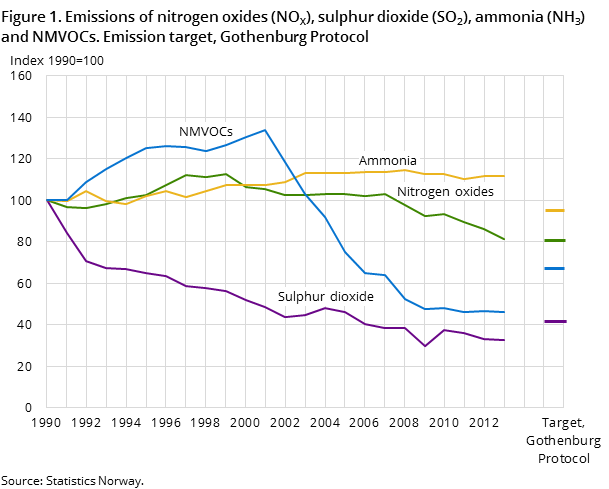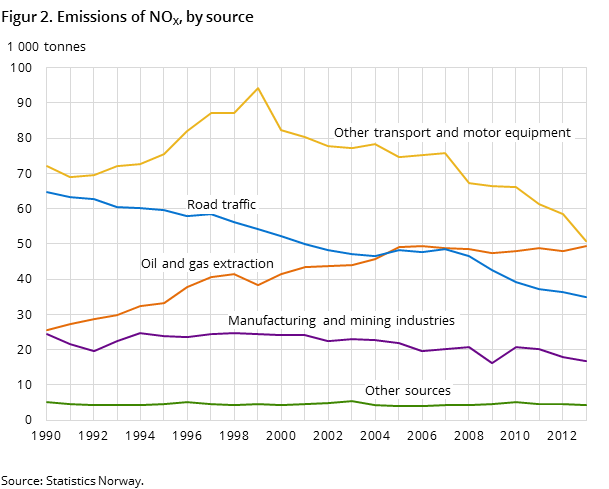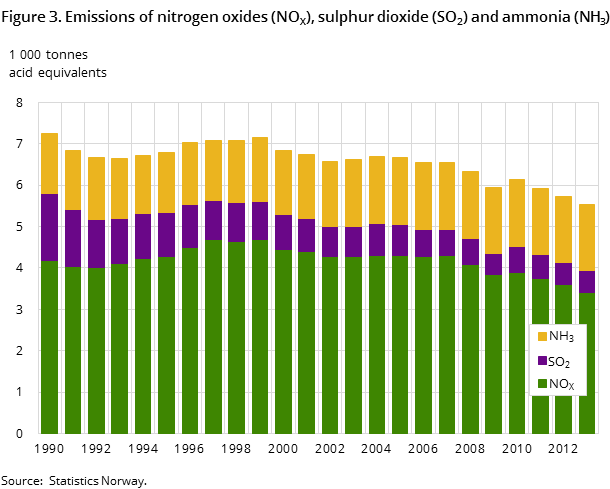Content
Published:
This is an archived release.
Emissions below NOx target in 2013
The emissions of nitrogen oxides fell by 5 per cent in 2013, continuing the previous year’s decrease. In 2013, Norway met its international obligations for emissions of NOx for the first time.
| 2013 | Change in per cent | ||
|---|---|---|---|
| Since 1990 | 2012 - 2013 | ||
| 1Does not include international sea and air traffic. | |||
| Nitrogen oxides (NOX) | 156 | -18.6 | -5.4 |
| Sulphur dioxide (SO2) | 17 | -67.4 | -1.6 |
| Ammonia (NH3) | 27 | 11.9 | 0.3 |
| Non-methane volatile organic compounds (NMVOC) | 135 | -53.7 | -0.8 |
| Carbon monoxide (CO) | 262 | -65.0 | -11.8 |



This figure is taken from the latest estimates of nitrogen oxides (NOX) for 2013. The emissions of sulphur dioxide (SO2), non-methane volatile organic compounds (NMVOC) and carbon monoxide (CO) decreased in 2013. The emission of ammonia (NH3) was steady.
Emissions of nitrogen oxides below the target
Norway emitted 156 000 tonnes of nitrogen oxides (NOX) in 2013, which is a 5 per cent decrease from 2012. The figures comprise emissions from domestic areas. The decline is mainly due to lower consumption of marine fuels in coastal navigation and fishing. There has also been a decline in emissions within mobile transportation. Recent years have seen a decline in the emissions due to the establishing of the industries’ fund for financing NOX reducing efforts (the NOX Fund) and due to cleaner motor technology.
According to the Gothenburg protocol, the Norwegian emissions were 154 000 tonnes in 2013, though with a slightly different delimitation of Norwegian emissions (see box). In 2013, the emissions were 2 000 tonnes below the ceiling in the Gothenburg protocol, which shall not exceed 156 000 tonnes per year by 2010. In 2013, Norway met its obligations.
Further reduction in sulphur emissions
The sulphur dioxide (SO2) emissions in Norway ended at 17 100 tonnes in 2013, a drop of 2 per cent from the previous year. Norway has reduced its sulphur emissions almost every year since 1990. The 2013 emission was just a third of the level of 1990. The sulphur emissions mainly stem from coal and coke consumption in metal manufacturing and combustion of heavy fuel oil in coastal navigation and fishing. Manufacturing and mining is still the main emitter of SO2 in Norway, accounting for 67 per cent of the total in 2013. The main reduction in sulphur emissions last year came within domestic navigation and manufacturing of paper/pulp and cement. The reductions in emissions since 1990 are mainly the result of using fossil fuels with lower sulphur content, improved pollution control, cleaner production technologies and the closure of pollution-generating businesses. The 2013 emissions were 23 per cent below the obligation set in the Gothenburg Protocol.
Steady ammonia emissions
The ammonia (NH3) emission was practically the same in 2013 as in 2012. There have been just small variations in the ammonia emissions since 1990. Agriculture is the dominating source, emitting 92 per cent of the national amount. Total emission in 2013 is estimated at 27 200 tonnes, which is 18 per cent more than the obligation set by the Gothenburg Protocol.
Steady volatile organics, less carbon monoxide
A slight decrease of one per cent in the non-methane volatile organic compounds (NMVOC) emissions, compared to the previous year, was seen in 2013, and ended at 134 800 tonnes. The decline is mainly due to lower firewood consumption in households. A 5 per cent emission growth was seen within oil and gas extraction, due to increased drilling activity. The long-term trend after 2001 is, however, a substantial decrease. The NMVOC emissions have declined by 65 per cent since 2001, and in 2012 ended 31 per cent below the Gothenburg obligation. Emission abatements within crude oil loading are the main cause. The NMVOC emissions are scattered among most source categories, and in 2013 ‘Other sources’, which include solvent use, was the largest category, comprising 36 per cent.
The emissions of carbon monoxide (CO) went down by 12 per cent in 2013 compared to the year before, and ended at 262 000 tonnes. The drop is mainly due to reduced firewood consumption in households, and a shift to diesel cars and general renewal of the car fleet. There has been a decline almost every year since 1990, and in 2013 the emissions reached only 35 per cent of the level in 1990. Earlier on, road traffic was the main emitter of carbon monoxide in Norway, but today wood-firing contributes the most. Norway has no international commitments regarding this pollutant.
Further reduction in acidifying emissions
The total emission of the three gases NOX, SO2 and NH3 in 2013, measured as acid equivalents, dropped by 3 per cent from the previous year, and by 24 per cent from 1990. The sulphur emission has shown the steepest decline from 1990, while the emissions of ammonia have increased. In 2013, NOX comprised 61 per cent of the emissions. When transforming the Gothenburg obligations to acid equivalents, the 2013 emissions exceeded the sum of emission ceilings by 1 per cent.
Norway is committed to further reductionOpen and readClose
The Gothenburg Protocol (2005, revised 2012) and the NEC directive established ceilings for the emissions of sulphur dioxide (SO2), nitrogen oxides (NOX), ammonia (NH3) and volatile organic compounds except methane (NMVOC).
The definition of which emissions are to be regarded as Norwegian differs somewhat in the Gothenburg Protocol from Statistics Norway’s emission statistics. The NOX emissions are about 1 per cent lower when using the Gothenburg Protocol definition, while smaller differences are found for the other gases.
Adjustments to the emission inventoryOpen and readClose
A revision of the emission factors for diesel engines, on off-road machinery, has caused a drop in emissions for almost all years for NOx, NMVOC, CO and NH3. Emissions of NH3 have increased.
The statistics is published with Emissions to air.
Contact
-
Statistics Norway's Information Centre
E-mail: informasjon@ssb.no
tel.: (+47) 21 09 46 42
